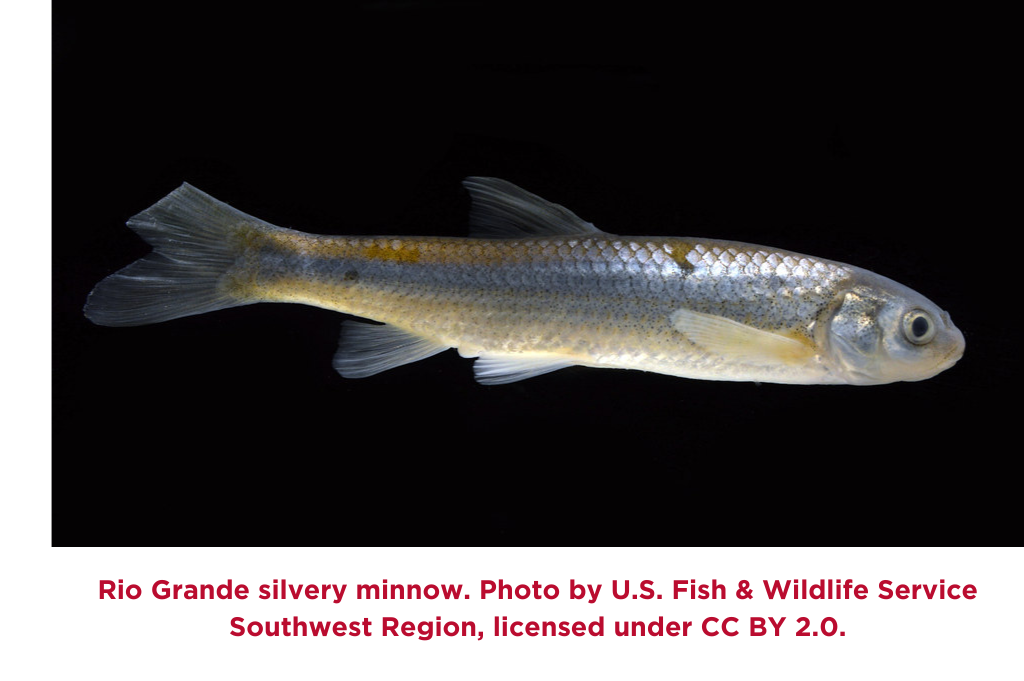Research efforts play a crucial role in rescuing a Rio Grande fish species from extinction
By Mariah Rosales
 In the heart of the Rio Grande basin, the Rio Grande Silvery Minnow (Hybognathus amarus), a unique fish species, is struggling to survive. Habitat changes, river disruptions caused by dams and water diversion structures, and recent severe drought conditions in the Southwestern United States have intensified the struggle for the Rio Grande Silvery Minnow, resulting in population bottlenecks and even population collapse. These events, linked to diminished snowmelt runoff and increased river drying, have threatened the species' reproductive success and recruitment.
In the heart of the Rio Grande basin, the Rio Grande Silvery Minnow (Hybognathus amarus), a unique fish species, is struggling to survive. Habitat changes, river disruptions caused by dams and water diversion structures, and recent severe drought conditions in the Southwestern United States have intensified the struggle for the Rio Grande Silvery Minnow, resulting in population bottlenecks and even population collapse. These events, linked to diminished snowmelt runoff and increased river drying, have threatened the species' reproductive success and recruitment.
These challenges have led to a significant reduction in the fish's historical range, with the species now found in less than 5% of its original habitat. Conservation efforts and advanced genetic monitoring are playing a crucial role in rescuing the Rio Grande Silvery Minnow from the brink of extinction.
Designated as endangered in 1994 under the Endangered Species Act, the Rio Grande Silvery Minnow's survival has been sustained by dedicated conservation efforts. Since 2003, silvery minnows that were bred or raised in captivity have been released into the Middle Rio Grande Conservancy District, preventing the species from teetering on the brink of extinction.
To understand the genetic impact of these conservation measures, a recent study, “Transitioning from microsatellites to SNP-based microhaplotypes in genetic monitoring programmes: Lessons from paired data spanning 20 years”, employed advanced genetic monitoring techniques. Using archived genetic material, University of New Mexico Biology Research Professor Megan Osborne and her colleagues Guilherme Caeiro-Dias and Thomas Turner from the Museum of Southwestern Biology identified new genetic markers across the silvery minnow’s DNA.
 “Our study highlights the importance of archiving both tissue and DNA samples collected during wildlife monitoring so they can be utilized as new genomic technologies are developed,” says Osborne. This expanded approach allows for a more comprehensive evaluation of genetic diversity compared to previous methods. The study marks a significant milestone, representing one of the longest genetic time-series analyzed at a population level in a freshwater fish species, lasting 20 years.
“Our study highlights the importance of archiving both tissue and DNA samples collected during wildlife monitoring so they can be utilized as new genomic technologies are developed,” says Osborne. This expanded approach allows for a more comprehensive evaluation of genetic diversity compared to previous methods. The study marks a significant milestone, representing one of the longest genetic time-series analyzed at a population level in a freshwater fish species, lasting 20 years.
To process the vast amount of sequencing data generated by the study, researchers utilized bioinformatic resources provided by computer clusters. This approach, facilitated by the Center for Advanced Research Computing, allowed for the identification of high-quality DNA building blocks which was crucial for the researchers’ genetic monitoring and analysis.
The Rio Grande Silvery Minnow has shown resilience in maintaining genetic variation despite periodic population collapses. This is attributed to integrated management strategies involving both wild and captive populations of the silvery minnow.
Despite the challenges faced by the Rio Grande Silvery Minnow, the species continues to navigate genetic hurdles, providing valuable insights for ongoing conservation efforts. “Our research also shows that it is feasible for conservation programs to use genomic methods for routine monitoring. This information can be used to continue effectively managing the Rio Grande Silvery Minnow.” says Osborne.
In the broader Rio Grande Basin, the Rio Grande Silvery Minnow stands as a testament to the importance of conservation measures in preserving unique and endangered species in the face of habitat threats and climatic challenges.
